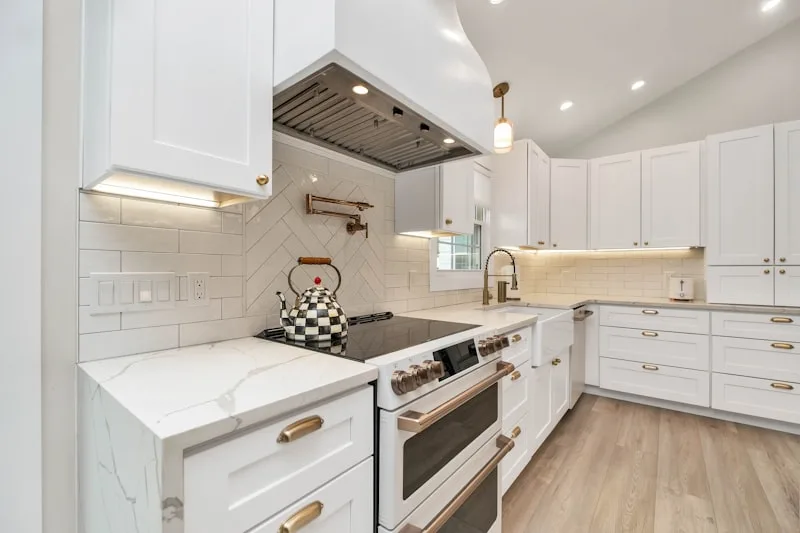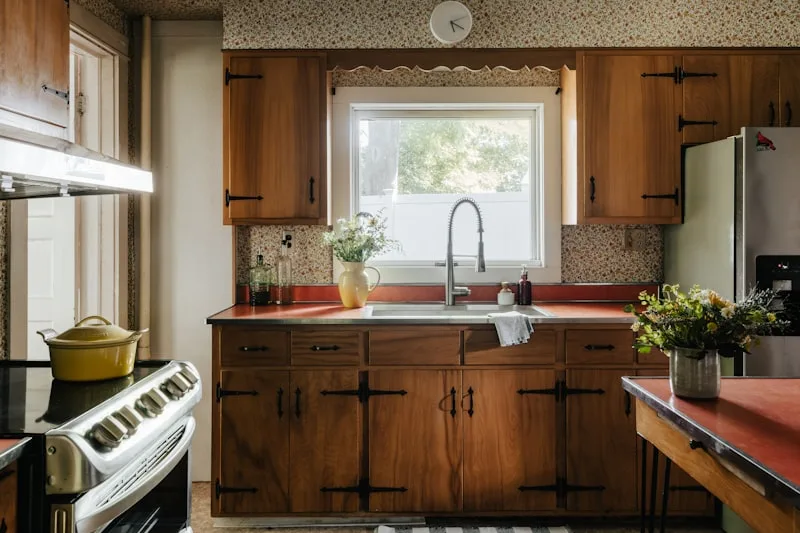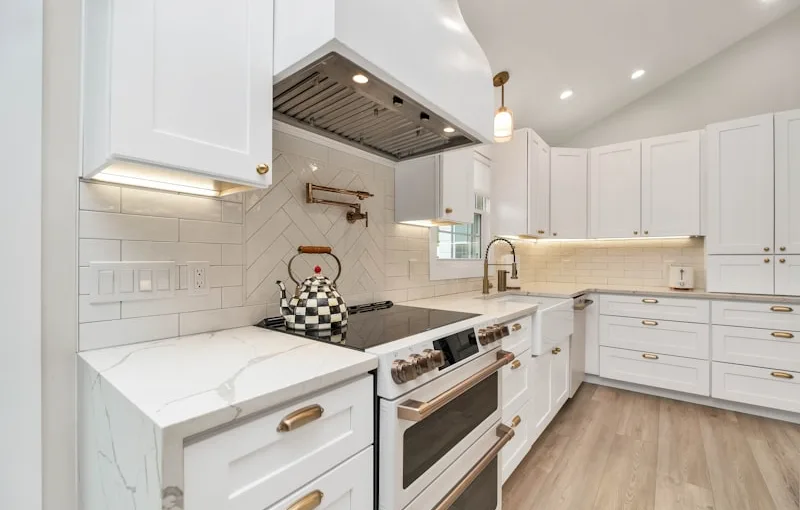Now, let’s talk about how to tackle this sticky situation. First off, you’ll want to gather your cleaning supplies. A gentle dish soap mixed with warm water is a great start. It’s like a superhero for your cabinets—powerful yet gentle. Grab a soft cloth or sponge, dip it in your soapy solution, and start wiping down those surfaces. Remember, you’re not scrubbing a floor; you’re treating your cabinets with care.
For those stubborn spots that refuse to budge, consider using a mixture of vinegar and water. It’s like a magic potion that cuts through grease without leaving a harsh chemical smell. Just spray it on, let it sit for a minute, and wipe it away. Voila! You’ll be amazed at how easily the grime lifts off.
And don’t forget to dry your cabinets thoroughly afterward. Leaving moisture behind can lead to more stickiness down the line. Think of it as giving your cabinets a refreshing spa day. With a little effort, you can transform your sticky cabinets back into the sleek, clean surfaces they were meant to be. So, roll up those sleeves and get ready to reclaim your kitchen!
Unraveling the Mystery: Why Your Kitchen Cabinets Are Sticky and How to Fix Them
First off, let’s talk about the culprits. Grease, grime, and moisture are the usual suspects. If you love cooking (and who doesn’t?), splatters and spills are bound to happen. Over time, these little accidents can build up, creating a sticky residue that’s hard to ignore. Think of it like a layer of glue that just won’t budge!
Now, you might be wondering, “How do I fix this?” Well, fear not! The solution is simpler than you think. Start with a good cleaning. Grab some warm water mixed with a few drops of dish soap. Use a soft cloth or sponge to wipe down those cabinets. It’s like giving them a refreshing spa day! For tougher spots, a mixture of vinegar and water can work wonders. Just remember to rinse and dry afterward to avoid any moisture lingering around.
But what if the stickiness keeps coming back? That’s where prevention comes into play. Consider using cabinet liners to protect the surfaces from spills. It’s like putting a raincoat on your cabinets! Also, make sure to keep your kitchen well-ventilated. A little airflow can go a long way in keeping that sticky residue at bay.
So, the next time you find yourself battling sticky cabinets, remember: it’s all about understanding the problem and taking action. With a little elbow grease and some smart strategies, you can keep your kitchen looking and feeling fresh!
Sticky Situation: The Surprising Causes of Grimy Kitchen Cabinets Revealed
First off, let’s talk about the sneaky little culprits: humidity and heat. If your kitchen is like a sauna, the moisture in the air can settle on your cabinets, mixing with dust and creating a sticky film. It’s like a science experiment gone wrong! And don’t forget about those cooking splatters. Even the most careful chef can end up with a splash of sauce or a sprinkle of flour that, over time, turns into a stubborn mess.
But wait, there’s more! Have you ever considered the cleaning products you use? Some sprays and wipes can leave behind a residue that attracts dirt like a magnet. It’s like putting a “Welcome” mat for grime right on your cabinets! And if you’re a fan of DIY projects, those crafty concoctions can sometimes backfire, leaving behind a sticky situation instead of a sparkling finish.
From Grime to Shine: Expert Tips for Cleaning Sticky Kitchen Cabinets
First off, grab your trusty cleaning supplies. You’ll need a gentle dish soap, warm water, and a microfiber cloth. Think of the soap as your superhero, ready to battle the sticky villains lurking on your cabinets. Mix a few drops of soap in a bowl of warm water, dip your cloth, and get ready to scrub away the grime.
Now, here’s a pro tip: always wipe in the direction of the wood grain. It’s like giving your cabinets a gentle massage, helping to lift away dirt without damaging the finish. If you encounter stubborn spots, don’t panic! A paste made from baking soda and water can work wonders. Just apply it to the sticky area, let it sit for a few minutes, and then wipe it off. It’s like magic—watch the grime disappear!

For those cabinets that seem to have a life of their own, consider using a mixture of vinegar and water. This dynamic duo not only cuts through grease but also leaves a fresh scent behind. Just remember to rinse with plain water afterward to avoid any lingering vinegar smell.
And if you want to keep your cabinets shining bright, a little bit of furniture polish goes a long way. It’s like giving your cabinets a spa day! Just a quick spritz and a wipe, and they’ll be gleaming like new.
So, roll up your sleeves and get ready to turn those sticky cabinets into a shining testament to your cleaning prowess!
The Science Behind Sticky Cabinets: Understanding the Build-Up and How to Combat It
First off, let’s talk about the culprits. Over time, cooking oils, food particles, and even moisture can cling to your cabinet surfaces. Think of it like a magnet attracting dust; the more you cook, the more these substances accumulate. When heat from cooking rises, it can cause oils to vaporize and settle on cooler surfaces, creating that sticky film. It’s a bit like a greasy fog that just won’t clear!
Now, you might be wondering, “How do I get rid of this gunk?” Well, fear not! A simple mixture of warm water and vinegar can work wonders. Vinegar is like the superhero of cleaning agents—its acidity cuts through grease like a hot knife through butter. Just grab a cloth, dip it in your vinegar solution, and wipe away that sticky mess.
But wait, there’s more! Prevention is key. To keep your cabinets from turning into a sticky trap, consider using a splatter guard while cooking. It’s like putting a shield around your culinary kingdom. Also, regularly wipe down your cabinets with a gentle cleaner to keep that build-up at bay.
So, the next time you encounter those sticky cabinets, remember: it’s just a little science at play. With a bit of understanding and some elbow grease, you can reclaim your kitchen space and keep it sparkling clean!
Say Goodbye to Sticky Cabinets: A Step-by-Step Guide to Effective Cleaning
First things first, gather your supplies. You’ll need warm water, a gentle dish soap, a microfiber cloth, and a soft sponge. Think of these items as your cleaning superheroes, ready to tackle the grime. Start by removing everything from the cabinet. It’s like decluttering your mind; once you clear the space, you can see what you’re working with.
Next, mix a few drops of dish soap into a bowl of warm water. This bubbly concoction is your secret weapon against sticky residue. Dip your microfiber cloth into the soapy water, wring it out, and start wiping down the surfaces. Imagine you’re giving your cabinets a refreshing spa day—who wouldn’t want that?
For those stubborn spots that refuse to budge, grab your soft sponge. Gently scrub the area, but don’t go too hard; you don’t want to scratch the finish. It’s like coaxing a shy friend out of their shell—patience is key!

Once you’ve tackled the sticky spots, rinse your cloth in clean water and wipe down the cabinets again to remove any soap residue. It’s like giving them a final rinse after a long day at the beach. Finally, dry everything with a clean towel to prevent water spots.
Now, step back and admire your handiwork. Those cabinets are looking fabulous! With just a little effort, you’ve transformed a sticky nightmare into a gleaming success. Who knew cleaning could feel this good?
Kitchen Cabinet Care: Why They Get Sticky and How to Restore Their Luster
So, why do kitchen cabinets get sticky in the first place? Well, cooking releases oils and vapors that settle on surfaces. If you’re frying up a storm or whipping up a batch of cookies, those delicious aromas come with a price. Over time, this residue can create a tacky film that’s not just unpleasant to touch but can also dull the finish of your cabinets. It’s like a fog rolling in on a sunny day, obscuring the beauty beneath.
Restoring the luster of your cabinets doesn’t have to be a daunting task. Start with a simple solution of warm water and mild dish soap. Grab a soft cloth and gently wipe down the surfaces, letting the soapy goodness work its magic. For those stubborn spots, a mixture of vinegar and water can be your secret weapon. It’s like giving your cabinets a refreshing spa day!
After cleaning, don’t forget to dry them thoroughly. Moisture can be a sneaky culprit that leads to more stickiness. If your cabinets are made of wood, consider applying a wood conditioner or polish to bring back that shine. It’s like putting on a fresh coat of paint—suddenly, everything looks brand new! So, next time you reach for that cabinet door, you’ll be greeted by a smooth, clean surface that feels just right.
Frequently Asked Questions
How Can I Prevent My Cabinets from Getting Sticky?
To prevent cabinets from becoming sticky, regularly clean them with a mild soap solution and dry thoroughly. Ensure proper ventilation in the kitchen to reduce humidity, and avoid using excessive oils or greasy substances near the cabinets. Consider applying a protective finish or wax to create a barrier against moisture and grime.
How Often Should I Clean My Kitchen Cabinets to Avoid Stickiness?
Regular cleaning of kitchen cabinets is essential to prevent stickiness. Aim to clean them every month with a gentle cleaner to remove grease and grime. For high-traffic areas, consider bi-weekly cleaning. This routine helps maintain a fresh appearance and prevents buildup that can lead to stickiness.
What Causes Sticky Kitchen Cabinets?
Sticky kitchen cabinets are often caused by a buildup of grease, food residue, and moisture. Over time, these substances can accumulate on surfaces, leading to a tacky feel. Additionally, high humidity levels and poor ventilation can exacerbate the problem, making it essential to maintain cleanliness and ensure proper airflow in the kitchen.
Are There Specific Products Recommended for Cleaning Sticky Cabinets?
For effectively cleaning sticky cabinets, it is recommended to use a mixture of warm water and mild dish soap. Additionally, products containing vinegar or baking soda can help break down sticky residues. For tougher stains, consider using a commercial degreaser specifically designed for kitchen surfaces. Always test any product on a small, inconspicuous area first to ensure it does not damage the finish.
What Are the Best Cleaning Methods for Sticky Cabinets?
To effectively clean sticky cabinets, start by mixing warm water with a few drops of dish soap. Use a soft cloth to gently scrub the sticky areas, ensuring not to damage the finish. For tougher residues, a solution of equal parts vinegar and water can be applied. Rinse with a damp cloth and dry thoroughly to prevent moisture damage. Regular maintenance with a suitable wood cleaner can help prevent stickiness in the future.
